MG25 GOLDEN FINGERS
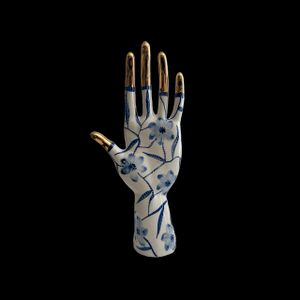
Elica Studio > Styling
MG25 GOLDEN FINGERS Material Porcelain, oxides, glaze, 24k gold Finishing Glossy Sizes (cm) 17 X 8 X 37 Weight (g) 1020 Designed in 2025 Collection Anatomika Lead Time: 30 days MG25 GOLDEN FINGERS is a sculptural porcelain piece designed with an arresting anthropomorphic quality. At its core lies a high-heeled foot—meticulously modelled with individual toes and a softly arched sole—anchoring the piece in tactile familiarity. Extending skyward from the ankle is a stylized boot-like shaft, culminating in a crown of elongated fingers rather than the expected heel. Each fingertip is lavishly coated in 24 K gold, creating a striking dialogue between grounded form and aspirational flourish. The piece masterfully balances realism and surrealism. The porcelain foot, finished in high-gloss glaze, reflects light softly yet confidently. The toes and arch bear subtle shading from engobes, hinting at musculature and depth. In contrast, the fingers ascend like delicate spires, their polished gilding catching ambient light and drawing the eye upwards—evoking themes of ritual, giving, and elegance. The gold finish appears almost molten, creating a luxurious focal point that balances tactile authenticity with visual opulence. Surface details give MG25 depth and character. The glossy glaze enhances the porcelain’s curvature while the gilded fingers shimmer in shifting light. Hand-applied engobes around sculpted areas accentuate volume and highlight craftsmanship. Overall, the piece feels both elegant and expressive, with each fingertip acting as a “gesture of offering.” Styling & Placement Suggestions Minimalist & Contemporary Interiors: Display MG25 as a lone sculptural statement on a console or pedestal under focused LED lighting. Its reflective glaze and gilded tips provide visual brilliance without overwhelming neutral palettes. Gallery-Style & Boutique Settings: Showcase MG25 with ample breathing space. Position it on a spotlit shelf or niche surrounded by understated backgrounds (e.g. dove-grey or cream) to accentuate its sculptural drama. Eclectic & Layered Environments: Group alongside matte ceramics, carved wooden pieces, or stone works. The glossy-gold contrast introduces vertical emphasis and adds luxe texture, complementing natural materials in a curated vignette. Hospitality & Retail Spaces: Use MG25 as an accent piece in reception areas, bar counters, or showroom displays. Its foot-and-finger form invites interaction while offering a poetic symbol of welcome or refinement. Why Designers Will Appreciate It Sculptural Narrative: Merges anatomical realism (foot) with symbolic abstraction (golden fingers), inviting interpretations on gesture, transformation, and ritual. Material Dialogue: Glossy porcelain and 24 K gold create tactile and visual contrast, enhancing light interaction and textural depth. Artistic Craftsmanship: Hand-formed details, shading, and subtle irregularities celebrate artisanal authenticity.
RUBUS
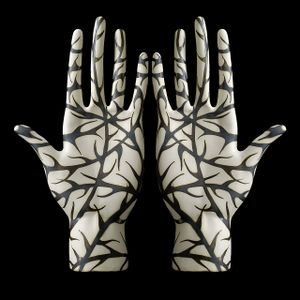
Elica Studio > Styling
RUBUS Material Porcelain, engobes Finishing Matte Sizes (cm) 17 X 8 X 37 Weight (g) 1020 Designed in 2021 Collection Anatomika Lead Time: 30 days RUBUS is a pair of sculptural porcelain hands, upright and open, each coated in a delicate matte ivory glaze and adorned with a dramatic black branch motif that flows organically across the surfaces. Standing approximately 35 cm tall, these hands are mirrored in form—left and right—each one anatomically refined, yet elevated into a striking canvas for nature-inspired abstraction. The defining feature of this piece lies in the high-contrast branch pattern that traverses the surface. The motif appears like a thicket or network of thorny vines, climbing across palms, fingers, and wrists with irregular grace. This intricate pattern is hand-painted, allowing for variation and depth that amplifies the tactile quality of the work. With a matte finish, the porcelain absorbs light, enhancing the softness of its contours and the tension of the linear black design. The contrast between the smooth ivory base and the bold, dark pattern creates a visual rhythm that is both graphic and lyrical—organic, yet highly controlled. Styling & Placement Recommendations Minimalist Interiors: Display the pair as a symmetrical focal point on a clean console or within a niche. Their verticality introduces balance and quiet symbolism into neutral spaces. Contemporary or Gallery-Like Settings: Place under directional lighting to emphasise the surface detail and shadow play between fingers and pattern. They become sculptural artefacts—part body, part botanical illustration. Eclectic or Textural Rooms: Style with natural elements like twisted branches, rough ceramics, or soft textiles to amplify the tension between human anatomy and wilderness imagery. Hospitality & Boutique Spaces: Position at reception desks or styling counters as eye-catching sculptural objects that convey both refinement and a hint of mystery. Why Designers Choose MANI ROVO Symbolic Contrast: The open hand—often a symbol of giving or receiving—becomes entangled in a graphic vine motif, suggesting themes of nature, struggle, or resilience. Dual Presence: As a pair, the hands offer compositional symmetry and narrative balance—ideal for styling in mirrored or opposing placements. Surface Expression: Matte ivory and sharp black detailing offer visual texture and high design impact without the need for colour. Conversation Piece: This work holds conceptual weight while maintaining a sculptural elegance, making it ideal for emotionally resonant, contemporary interiors. Styling Tip: Position the pair against a black or neutral backdrop and cast light from the side to reveal depth between the fingers and branches. For a dramatic setting, allow space around them to let their quiet presence stand uninterrupted. MANI ROVO is not just a sculptural object—it’s a visual dialogue between anatomy and nature, openness and entanglement. Perfect for interiors that invite emotion, contrast, and handcrafted storytelling.
DM22 GOLD
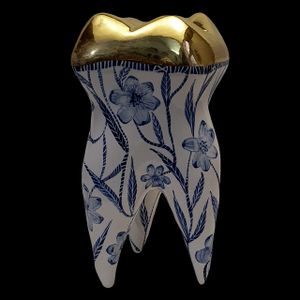
Elica Studio > Styling
DM22 GOLD Material Porcelain, glaze, oxides, 24 k gold Finishing Glossy Sizes (cm) 18 X 19 X 36 Weight (g) 1300 Designed in 2022 Collection Anatomika Lead Time: 30 days DM22 GOLD is a sculptural porcelain object shaped as a molar tooth, elevated through ornamental pattern and precious material. The anatomical form is softened and stylised, crowned with a lustrous 24 K gold glaze that flows naturally over the enamel-like surface. The body, in contrast, is adorned with intricate hand-painted cobalt blue flowers and leaves, recalling Delftware or traditional ceramic painting. The tension between the luxurious gold top and the delicate floral decoration below creates a duality—bold and refined, organic and precious. The matte ivory porcelain base absorbs light softly, while the gold surface reflects it with intensity, making the tooth both tactile and luminous. Hand-painted botanical elements climb across the curved form with natural fluidity. Their cobalt tone stands in crisp contrast to the ivory background, adding detail and visual softness to the robust shape. The result is a sculptural object that plays with contrast, tradition, and reinterpretation. Styling & Placement Suggestions Luxury Interiors: Display as a standout sculptural element on a sideboard or console. The gold finish catches light and attention, making it ideal for high-impact visual placement. Contemporary Classic Spaces: Use in interiors where historical patterns meet modern forms. The floral painting recalls classic ceramics, while the gold adds a contemporary finish. Gallery and Display Environments: Position on a pedestal or shelf under spotlighting to enhance surface contrast and decorative detail. Eclectic or Curated Spaces: Mix with ceramic vessels, natural textures, or metallics. The piece bridges fine art and design, ideal for collectors and narrative-driven styling. Why Interior Designers Appreciate DM22 GOLD Material Luxury: The 24 K gold glaze creates a luminous, high-end finish with artisanal detail. Pattern + Form: A contemporary anatomical object is transformed through traditional floral painting—blending body, craft, and history. Visual Tension: Matte and gloss, floral softness and metallic shine, all in a single balanced form. Versatile Statement: At 25 cm, it anchors tablescapes, niches, and display settings without overwhelming space. Styling Tip: Illuminate from above to let the gold reflect while casting shadows into the recessed floral design. For a refined pairing, surround with neutral tones or raw textures to highlight the porcelain’s intricacy. DM22 GOLD is a sculptural artefact that transforms an ordinary symbol into an object of ornate beauty. Both intimate and bold, it invites narrative, elegance, and contradiction—perfect for interiors defined by thoughtful contrasts and rich material storytelling.
DM22 WIRE
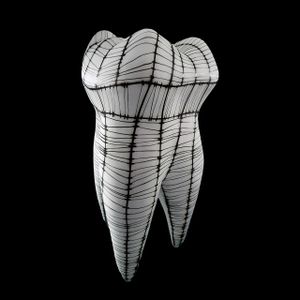
Elica Studio > Styling
DM22 WIRE Material Porcelain, oxides, glaze Finishing Matte Sizes (cm) 18 X 19 X 36 Weight (g) 1300 Designed in 2022 Collection Anatomika Lead Time: 30 days DM22 WIRE is a sculptural object that reinterprets the human molar through a contemporary lens. Crafted from fine porcelain, the form is anatomical yet stylised, finished in a high-gloss white glaze and overlaid with a dynamic black wire-like graphic that traces its surface with energy and intent. The decoration is entirely hand-painted: irregular vertical and horizontal lines bend across the volume of the form, intersecting in a loose grid that mimics tension, wrapping, or topography. Each line appears almost as if drawn in ink, with varying weight and movement, creating a surface alive with rhythm and controlled chaos. The glossy finish adds dimension—catching light across the curves and amplifying the bold black linework. Despite its monochrome palette, the piece commands attention through contrast, shape, and surface complexity. The root forms are distinct and expressive, grounding the piece in its biological inspiration while abstracting it into sculpture. Styling & Placement Suggestions Contemporary Minimalist Spaces: Use as a high-contrast focal object on open shelving or a floating console. The linear motif brings energy to neutral interiors. Design-Forward Environments: Position DM22 WIRE under spotlighting in studio spaces, concept stores, or gallery-style installations where bold graphics and unusual forms are celebrated. Eclectic or Graphic Rooms: Pair with black, white, or stone elements to build visual tension. Works beautifully with textured ceramics and matte finishes. Boutique Hospitality Spaces: Place at reception areas or within curated display units to introduce a conversation piece that merges design, anatomy, and visual rhythm. Why Designers Specify DM22 WIRE Visual Energy: The expressive hand-painted wire motif creates tension and movement across a static form. Monochrome Precision: Black on gloss white delivers maximum contrast without colour, perfect for refined and modern palettes. Symbolic Layering: As a tooth, it offers associations of memory, structure, or resilience—elevated through abstraction. Gallery-Ready Presence: Sculptural scale and surface detailing make it suitable for curated interiors or public-facing displays. Styling Tip: Position under angled light to cast sharp shadows that interact with the wire pattern. Against a black or concrete wall, it becomes graphic and sculptural—an object with bold presence and subtle detail. DM22 WIRE transforms a familiar anatomical form into a design object charged with visual rhythm and conceptual intrigue. It is an ideal addition to interiors seeking graphic clarity, storytelling through material, and sculptural power within compact scale.
OCC 22 b
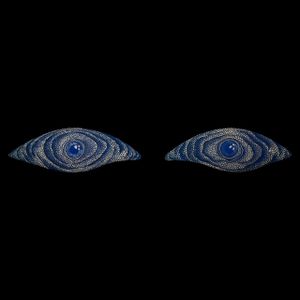
Elica Studio > Styling
OCC 22 d Material Porcelain, engobes, oxides, glaze Finishing Matte Sizes (cm) 38154 Weight (g) 900 Designed in 2022 Collection Anatomika Lead Time: 30 days OCC22 B is a sculptural porcelain object in the form of an open eye—stylised, surreal, and meticulously detailed. Sold as a pair, these pieces are mirror images, each handcrafted to resemble an almond-shaped eye with intricate surface patterns and a glossy cobalt pupil at the centre. The surface is textured with a ripple-like motif made from thousands of small incised dots, creating a layered effect that mimics both iris striations and concentric waves. Alternating bands of blue pigment and natural porcelain form a hypnotic rhythm that draws the viewer inward. The central pupil is a glossy sphere, polished and deep blue, offering a reflective focal point within the matte surround. This interplay of textures—matte stippling and glazed smoothness—gives OCC22 B a dual nature: tactile and visual, decorative and symbolic. Mounted on a wall or placed flat on a surface, the eyes seem to watch silently, evoking themes of perception, presence, and silent observation. Styling & Placement Suggestions Gallery or Conceptual Interiors: Install as a pair on a dark wall or framed niche. Their sculptural quality and abstract symbolism make them ideal for reflective or artistic spaces. Modern or Graphic Environments: Combine with linear or monochrome elements. The blue-and-white palette introduces intensity without colour noise, and the circular eye form breaks angular compositions. Minimalist and Spiritual Spaces: Use in meditation rooms or thoughtful corners as symbolic protectors or emblems of awareness. Retail and Hospitality: Perfect for reception areas, boutique walls, or hotel suites—OCC22 B adds both intrigue and storytelling without overwhelming a space. Why Interior Designers Choose OCC22 B Symbolic Clarity: A timeless symbol—open eyes—reimagined with depth, texture, and craft. Handmade Detail: The dotwork and pigment layers reveal the maker’s hand and material care. Sculptural Versatility: Can be wall-mounted or displayed flat; suitable for pair or single use. Compact Impact: At under 20 cm, each piece is small but visually powerful—ideal for curated compositions or spatial accents. Styling Tip: Mount the eyes at eye-level or slightly above for optimal visual engagement. Soft directional lighting will enhance the shadows within the dotted pattern and make the glazed pupils gleam subtly—drawing in the gaze of the viewer. OCC22 B is not just a decorative object—it’s a sculptural emblem of presence, reflection, and silent storytelling. Perfect for interiors that value narrative and detail, it brings symbolic weight with visual lightness.
OCC 22 a
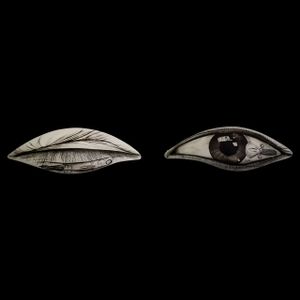
Elica Studio > Styling
OCC 22 a Material Porcelain, engobes, oxides, glaze Finishing Matte Sizes (cm) 38 X 15 X 4 Weight (g) 900 Designed in 2022 Collection Anatomika Lead Time: 30 days OCC22 A is a paired porcelain eye sculpture, where observation meets surreal narrative. Each eye is almond-shaped and sculpted from fine porcelain, with matte ivory glaze acting as a soft base for a highly detailed monochrome illustration. One eye is fully open, revealing a hyper-realistic iris and an illustrated surgical tool embedded in the lower lid. The second is closed—its lid feathered with fine ink-like linework and partially sealed by the same stylised tool motif. The use of cross-hatching and dense line drawing gives the eyes a poetic unease—one aware, the other sleeping, both marked by intrusion. The contrast between anatomical form and medical device hints at vulnerability, the line between seeing and being seen, or the discomfort of knowing. The asymmetry between the two eyes (one open, one shut) allows for more dynamic compositions and a deeper interpretive layer. Styling & Placement Suggestions Conceptual or Gallery Interiors: Display side-by-side on a neutral surface or wall-mounted as a symbolic diptych. Works well in narrative-driven spaces with high design awareness. Modern Minimalist Environments: Place above consoles or shelves as visual punctuation. Their quiet tone and detailed graphic quality suit monochrome interiors. Boutique & Artistic Studios: Ideal for creative offices, salons, or reception desks—especially where narrative, design, and symbolism matter. Reflective Spaces: OCC22 A can anchor areas designed for introspection, such as reading rooms, meditation nooks, or personal studios. Why Interior Designers Use OCC22 A Narrative Duality: Open and closed eyes create a sculptural dialogue of tension, presence, and privacy. Hand-Drawn Detail: Intricate black ink-like illustrations contrast softly with the ivory porcelain. Compact Impact: Modest in scale but emotionally dense—ideal for focal points in small vignettes. Metaphoric Versatility: Themes of surveillance, vulnerability, or poetic silence make this pair conceptually rich. Styling Tip: Use soft top lighting to enhance shadows within the linework and gently illuminate the curve of the form. Against a dark or textured background, the porcelain will pop subtly while the illustrations stay haunting and precise. OCC22 A is more than a visual accent—it is a sculptural metaphor. A gaze partially shielded, a lid half-closed, a tension unresolved. Perfect for interiors that thrive on narrative, silence, and deep visual thought.
PDP23 – Piatto da pompa BOCCA
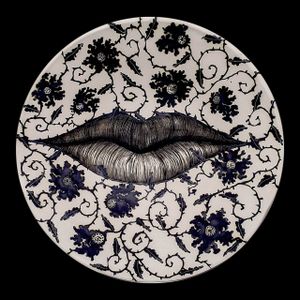
Elica Studio > Styling
Name: PDP23 – Piatto da pompa BOCCA Material: Porcelain, engobes, oxides Finishing: Matte Sizes (cm): 43x43 Weight (g): 2000 Designed in: 2023 Collection: Anatomika Description: Elevate your interior design projects with the PDP23 – Piatto da pompa BOCCA, a striking and unconventional piece from Elica Studio’s Anatomika Collection. This large, square porcelain plate, designed in 2023, presents a bold artistic statement, transforming a functional object into a captivating piece of decorative art. The plate features a highly stylized, graphic representation of lips, reminiscent of a "black bandana" motif, rendered with sharp lines and a stark contrast against the matte porcelain surface. This piece is ideal for interior designers seeking to introduce an element of edgy sophistication and contemporary artistic flair into their projects. Crafted with meticulous attention to detail, the plate showcases the beauty of porcelain, enhanced by the subtle texture of engobes and the rich depth of oxides. The matte finish not only adds a touch of understated elegance but also ensures that the bold graphic takes center stage, avoiding any distracting reflections. The "black bandana" lips design is both intriguing and provocative, making this plate a conversation starter and a focal point in any setting. Its square shape and substantial size (43x43 cm) command attention, while its weight of 2000g speaks to its quality and craftsmanship. The PDP23 – Piatto da pompa BOCCA is more than just a decorative object; it is a statement of artistic intent. Its bold design challenges conventional notions of beauty and functionality, making it a perfect fit for contemporary interiors that embrace individuality and artistic expression. Imagine it displayed on a minimalist console, adding a touch of rebellious elegance to a modern living room, or used as a striking centerpiece on a dining table, sparking conversation and intrigue among guests. Its inclusion in a design scheme signals a commitment to originality and a willingness to push the boundaries of traditional aesthetics. The Anatomika Collection, from which this piece originates, explores the beauty and complexity of the human form, reinterpreting anatomical elements through a contemporary lens. The PDP23 – Piatto da pompa BOCCA, with its bold representation of the mouth, perfectly embodies this artistic philosophy. It invites contemplation and adds a layer of sophisticated intrigue to any space. Its unique design and high-quality craftsmanship make it a valuable addition to any interior designer's repertoire, offering a way to create spaces that are not only visually stunning but also intellectually stimulating. This piece is a testament to Elica Studio's dedication to artistic innovation and their ability to transform everyday objects into extraordinary works of art.
BHR24 – ROCCO’S HEAD CAESAR
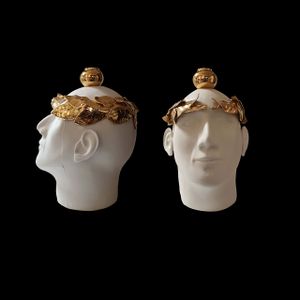
Elica Studio > Styling
BHR24 – ROCCO’S HEAD CAESAR Material Porcelain, glaze, 24 k gold Finishing Matte and glossy Sizes (cm) 30 X 28 X 38 Weight (g) 1500 Designed in 2024 Collection Anatomika Lead Time: 30 days Description: The BHR24 ROCCOS HEAD CAESAR, a regal and sophisticated piece from the Anatomika Collection, embodies timeless elegance and a commanding presence. Designed in 2024, its aesthetic is defined by a serene matte white glazed head, adorned with a meticulously gold-plated laurel wreath and crowned with a small, golden spherical finial. This piece offers interior designers an unparalleled opportunity to infuse spaces with classical grandeur, refined luxury, and a touch of historical gravitas, making it an indispensable asset for creating truly distinguished environments. For interior designers, the BHR24 ROCCOS HEAD CAESAR is an exceptionally versatile and impactful design element. The striking contrast between the pure, unadorned matte white porcelain and the rich, shimmering gold of the laurel wreath creates a visually arresting focal point. This sculpture is ideally suited for spaces that aim to evoke a sense of classical antiquity reimagined for the modern age, or for those seeking to add an element of opulent sophistication. Imagine it prominently displayed on a polished mahogany desk in a luxurious study, or gracing a grand entrance console in a high-end residential property. In a prestigious corporate office, a historical society's reception area, or a luxury hotel, the "Caesar" head can symbolize leadership, achievement, and enduring excellence, aligning with brands that value heritage and distinction. The artistic inspiration behind the Anatomika Collection, and particularly the CAESAR design, is a direct homage to classical Roman portraiture and the symbolism of triumph and authority represented by the laurel wreath. This profound historical connection provides interior designers with a rich narrative to integrate into their projects, allowing them to craft spaces that are not only aesthetically pleasing but also steeped in cultural significance and intellectual depth. It's more than just a decorative object; it’s a statement of enduring power and artistic legacy. For residential projects, this can create an atmosphere of scholarly elegance and cultivated taste. In commercial environments, it can contribute to a unique and memorable brand identity, attracting clientele who appreciate timeless design and a sense of gravitas. Practical considerations are well-addressed by the BHR24 ROCCOS HEAD CAESAR. Crafted from durable fine porcelain, it ensures longevity and maintains its exquisite appearance over time, making it a sustainable and enduring investment. The matte white glaze is elegant and easy to maintain, while the gold plating on the laurel wreath and finial is expertly applied for lasting brilliance and resistance to tarnishing. A lead time of 30 days allows for efficient project planning and seamless integration into design schedules. Its stable weight and balanced dimensions make it suitable for a wide range of placements, from prominent display on a central pedestal to a subtle yet impactful accent within a curated display case. The detailed craftsmanship of the laurel leaves further enhances its perceived value and visual richness. In terms of SEO, keywords crucial for interior designers searching for such pieces include "classical head sculpture," "gold laurel wreath decor," "Roman inspired art," "luxury white and gold sculpture," "statement presidential decor," "historical porcelain art," and "opulent office decor." These terms accurately describe its aesthetic, conceptual depth, and suitability for various luxurious and classically-inspired design applications, ensuring it is discoverable by professionals looking to infuse their projects with a blend of historical grandeur and contemporary elegance. The timeless appeal of gold and white ensures its adaptability across diverse interior styles, from traditional to transitional to modern classic. In conclusion, the BHR24 ROCCOS HEAD CAESAR from the Anatomika Collection is an exceptional piece that offers more than just decorative appeal. It is a powerful artistic statement and a versatile design element capable of transforming interiors into dynamic, sophisticated, and historically resonant environments. Its unique blend of classical homage and refined craftsmanship, combined with high-quality materials and thoughtful design, makes it an indispensable resource for interior designers committed to crafting truly distinctive and inspiring spaces for their discerning clientele.
BHR25 LOCK
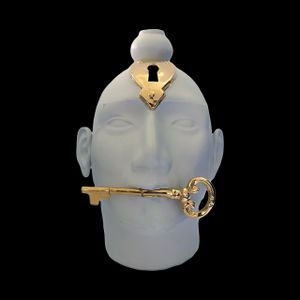
Elica Studio > Styling
BHR25 LOCK Material Porcelain, glaze, 24 k gold Finishing Matte and glossy Sizes (cm) 30 X 25 X 39 Weight (g) 1550 Designed in 2025 Collection Anatomika Lead Time: 30 days Description: The BHR25 LOCK, a profoundly symbolic and exquisitely crafted piece from the Anatomika Collection, stands as a captivating testament to modern porcelain artistry. This intriguing sculpture is designed in 2025, its striking aesthetic is defined by a serene matte white glazed head, adorned with prominent gold-plated accents: an intricate lock emblem situated on the forehead and a magnificent vintage-style key held poised between the lips. This piece offers interior designers an unparalleled opportunity to infuse spaces with intellectual depth, symbolic richness, and a touch of opulent mystery, making it an indispensable asset for creating truly distinctive environments. For interior designers, the BHR25 LOCK is an exceptionally versatile and impactful design element that immediately sparks curiosity and conversation. The powerful juxtaposition of the pure, unadorned white porcelain with the luxurious, reflective gold key and lock creates a dynamic visual narrative. This sculpture is ideally suited for spaces that aim to evoke a sense of intrigue, security, knowledge, or the unfolding of secrets. Imagine it as a central focal point on a dark, minimalist desk in a private study, where its symbolic nature can inspire contemplation. In a high-end commercial space, such as a law firm's reception area, a bespoke library, or a luxury hotel suite, the "LOCK" head can subtly convey themes of trust, access, and hidden depths, aligning with brands that value discretion and intellectual elegance. Its unique design ensures it will be a memorable feature for clients and visitors alike. The artistic inspiration behind the Anatomika Collection, and particularly the LOCK design, delves into profound philosophical themes such as knowledge, secrecy, access, and personal truth. The lock on the forehead can symbolize the mind's secrets or the gateway to understanding, while the key in the mouth might represent unspoken truths, the power of words, or the ability to unlock potential. This rich thematic tapestry provides interior designers with a compelling narrative to integrate into their projects, allowing them to craft environments that are not only visually stunning but also intellectually stimulating and emotionally resonant. For residential projects, this sculpture can foster an atmosphere of sophisticated elegance and artistic whimsy, encouraging personal reflection. In commercial environments, it can contribute to a unique and memorable brand identity, attracting clientele who appreciate bespoke craftsmanship and thought-provoking design. Practical considerations are well-addressed by the BHR25 LOCK. Crafted from durable fine porcelain, it ensures longevity and maintains its exquisite appearance over time, making it a sustainable and enduring investment. The matte white glaze is elegant and easy to maintain, while the gold plating on both the key and lock is expertly applied for lasting brilliance and resistance to tarnishing. A lead time of 30 days allows for efficient project planning and seamless integration into design schedules. Its stable weight and balanced dimensions make it suitable for a wide range of placements, from prominent display on a central console to a subtle yet impactful accent within a curated display case. The meticulous detailing of both the key and lock, along with the precise placement, underscore the craftsmanship involved. In conclusion, the BHR25 LOCK from the Anatomika Collection is far more than a decorative item; it is a profound artistic statement and a versatile design tool capable of transforming interiors into dynamic, sophisticated, and intellectually stimulating environments. Its unique blend of intriguing symbolism, refined craftsmanship, and bold design, combined with high-quality materials and thoughtful execution, makes it an indispensable resource for interior designers committed to crafting truly distinctive and inspiring spaces for their discerning clientele.
SYS 22 TEETH
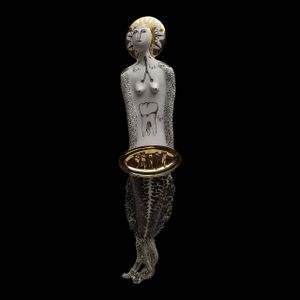
Elica Studio > Styling
SYS 22 TEETH Material Porcelain, engobes, oxides, glaze, 24 k gold Finishing Matte and glossy Sizes (cm) 12 X 50 Weight (g) 800 Designed in 2022 Collection Anatomika Lead Time: 30 days Description: The SYS22 TEETH, an exceptionally provocative and intellectually stimulating piece from the Systema Collection, is a masterwork of fine porcelain artistry designed to ignite conversation and inject bold, conceptual design into sophisticated interiors. Its striking aesthetic is defined by a serene matte white glazed body, adorned with precise black ink-style illustrations that depict anatomical features, notably a large, detailed tooth prominently centered on the torso. The most captivating elements are the lustrous gold-plated accents: a distinctive top element suggesting a halo or a crown, and a central gold-plated disc showcasing miniature, detailed teeth, reinforcing the collection's name and its central theme. This piece offers interior designers an unparalleled opportunity to introduce a sophisticated blend of scientific inquiry, artistic expression, and opulent detail into their projects. For interior designers, the SYS22 TEETH is an exceptionally versatile and impactful design element that demands attention and encourages deep contemplation. The elongated, almost columnar form, suggestive of a human torso or a symbolic pillar, provides a unique vertical presence that can anchor a space or serve as a compelling focal point. The juxtaposition of the pure, anatomical white porcelain with the precise black illustrations and the opulent gold accents creates a dynamic visual narrative. This sculpture is ideally suited for spaces that aim to evoke a sense of intellectual curiosity, artistic deconstruction, or a refined modern aesthetic with a philosophical edge. Imagine it prominently displayed in a sleek, minimalist medical office or dental clinic, where its artistic yet anatomical focus can resonate with the professional environment. Alternatively, in a high-end conceptual art gallery, a university's science department lobby, or a collector's private study, the SYS22 TEETH can symbolize the pursuit of knowledge, the intricacies of the human body, or the fusion of science and art, aligning with institutions and individuals that value intellectual depth and cutting-edge design. The artistic inspiration behind the Syrante Collection, and particularly the TEETH design, delves into the understanding of the human body and its components, often exploring themes of fragility, resilience, and the beauty found in biological structures. The detailed depiction of the tooth, alongside other anatomical or scientific diagrams, transforms a common biological element into a subject of artistic reverence and intellectual inquiry. This rich thematic tapestry provides interior designers with a compelling narrative to integrate into their projects, allowing them to craft environments that are not only visually stunning but also intellectually stimulating and emotionally resonant. For residential projects, this sculpture can elevate a study, a refined living area, or a bespoke collection, fostering an atmosphere of cultured elegance and scientific curiosity. In commercial environments, it can contribute to a unique and memorable brand identity, attracting clientele who appreciate bespoke craftsmanship and a design that challenges and inspires. Practical considerations are well-addressed by the SYS22 TEETH. Crafted from durable fine porcelain, it ensures longevity and maintains its exquisite appearance over time, making it a sustainable and enduring investment. The matte white glaze is elegant and easy to maintain, while the black ink-style illustrations are permanently fixed, ensuring their intricate details endure. The gold-plated elements are expertly applied for lasting brilliance and resistance to tarnishing, adding a touch of unparalleled luxury. A lead time of 30 days allows for efficient project planning and seamless integration into design schedules. Its substantial weight and balanced dimensions ensure stability, making it suitable for various placements, from prominent display on a central pedestal to a commanding presence in a curated vignette. The multi-faceted visual appeal, combining symbolic meaning with aesthetic beauty, ensures it remains a captivating presence.
SYS 22 PENIS
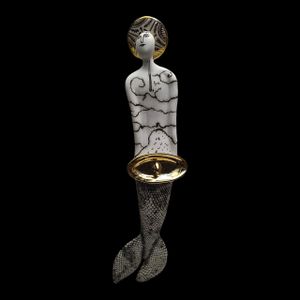
Elica Studio > Styling
SYS 22 PENIS Material Porcelain, engobes, oxides, glaze, 24 k gold Finishing Matte and glossy Sizes (cm) 12 X 50 Weight (g) 800 Designed in 2022 Collection Anatomika Lead Time: 30 days Description: The SYS22 PENIS, an audaciously conceptual and powerfully symbolic piece from the Syrante Collection, is an exceptional work of fine porcelain artistry designed to challenge norms and inject a bold, philosophical statement into sophisticated interiors. Its striking aesthetic is defined by a serene matte white glazed body, adorned with precise black ink-style illustrations reminiscent of anatomical diagrams or ancient glyphs. The most prominent and captivating elements are the lustrous gold-plated accents: a distinctive top element suggesting a halo or crown, and a central gold-plated motif representing the penis, directly reflecting the collection's name and its central theme of biological systems. This piece offers interior designers an unparalleled opportunity to introduce a sophisticated blend of artistic expression, symbolic depth, and opulent detail into their projects, designed to provoke thought and stimulate conversation. For interior designers, the SYS22 PENIS is an exceptionally versatile and impactful design element that demands attention and encourages deep contemplation. The elongated, columnar form, suggestive of a human torso or a symbolic pillar, provides a unique vertical presence that can anchor a space or serve as a compelling focal point. The juxtaposition of the pure, anatomical white porcelain with the precise black illustrations and the opulent gold accents creates a dynamic visual narrative. This sculpture is ideally suited for spaces that aim to evoke a sense of intellectual curiosity, artistic deconstruction, or a refined modern aesthetic with a philosophical edge. Imagine it prominently displayed in a sleek, minimalist art collector's home, where its symbolic illustrations can inspire thought, or commanding attention in a high-end, progressive art gallery. In environments that embrace bold artistic statements and explore themes of human nature, sexuality, or existence, the SYS22 PENIS can symbolize creation, virility, strength, or the celebration of the human form, aligning with spaces that value intellectual depth and cutting-edge design. The artistic inspiration behind the Systema Collection, and particularly the PENIS design, delves into the systematic understanding of the human body and universal principles, often exploring themes of life, masculinity, and the inherent power within creation. The anatomical drawings and the explicit symbolic representations transform a biological element into a subject of artistic reverence and intellectual inquiry. This rich thematic tapestry provides interior designers with a compelling narrative to integrate into their projects, allowing them to craft environments that are not only visually stunning but also intellectually stimulating and emotionally resonant. For residential projects, this sculpture can elevate a private study, a refined living area, or a bespoke collection, fostering an atmosphere of cultured elegance and artistic daring. In commercial environments, it can contribute to a unique and memorable brand identity for forward-thinking spaces, attracting clientele who appreciate bespoke craftsmanship and a design that challenges and inspires. Practical considerations are well-addressed by the SYS22 PENIS. Crafted from durable fine porcelain, it ensures longevity and maintains its exquisite appearance over time, making it a sustainable and enduring investment. The matte white glaze is elegant and easy to maintain, while the black ink-style illustrations are permanently fixed, ensuring their intricate details endure. The gold-plated elements are expertly applied for lasting brilliance and resistance to tarnishing, adding a touch of unparalleled luxury. A lead time of 30 days allows for efficient project planning and seamless integration into design schedules. Its substantial weight and balanced dimensions ensure stability, making it suitable for various placements, from prominent display on a central pedestal to a commanding presence in a curated vignette. The multi-faceted visual appeal, combining symbolic meaning with aesthetic beauty, ensures it remains a captivating presence. In conclusion, the SYS22 PENIS from the Syrante Collection is far more than a decorative item; it is a profound artistic statement and a versatile design tool capable of transforming interiors into dynamic, sophisticated, and intellectually stimulating environments. Its unique blend of intriguing symbolism, refined craftsmanship, and bold design, combined with high-quality materials and thoughtful execution, makes it an indispensable resource for interior designers committed to crafting truly distinctive and inspiring spaces for their discerning clientele.
BIRD VOU25 Ogiva vase
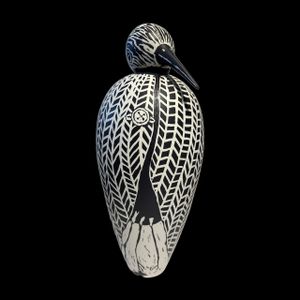
Elica Studio > Styling
BIRD VOU25 Ogiva vase Material Porcelain, engobes, glaze, 24k gold Finishing Matte Sizes (cm) 19 X19 X 47 Weight (g) 2200 Designed in 2025 Collection Naturalia Lead Time: 30 days Description: The BIRD VOU25 Ogiva vase stands as a testament to contemporary ceramic artistry, a piece meticulously crafted to captivate and inspire. Designed in 2025 as part of the esteemed "Naturalia" collection, this sculptural vase transcends mere functionality, evolving into a sophisticated statement piece for discerning interior designers. Its distinctive "Ogiva" silhouette, reminiscent of a gracefully elongated egg or a pointed arch, forms the body of a stylized bird, embodying a fusion of organic form with modern minimalist aesthetics. This striking design, envisioned by Elica Studio, brings a unique narrative to any space it inhabits, making it an indispensable element for bespoke luxury interiors. Crafted from exquisite porcelain, the BIRD VOU25 Ogiva vase showcases a masterful application of engobes and glazes, culminating in a refined matte finish. This tactile surface diffuses light beautifully, lending the piece a soft, understated elegance that is both inviting and visually intriguing. The monochrome palette, predominantly black and white as seen in the striking illustration, is a deliberate choice, offering a timeless sophistication that seamlessly integrates into a myriad of design schemes. The intricate, almost feather-like patterns adorning the bird's body are a hallmark of artisanal excellence, each line and curve speaking to the meticulous attention to detail and the artistic vision behind its creation. These patterns not only add visual depth and texture but also subtly evoke the organic beauty of nature, aligning perfectly with the "Naturalia" collection's ethos. What truly elevates the BIRD VOU25 Ogiva vase into the realm of high-end decorative art is the discreet yet impactful integration of 24k gold. While not overtly prominent in a monochromatic visual, the presence of genuine gold within its composition speaks volumes about the vase's luxurious quality and the uncompromising pursuit of excellence. This touch of precious metal adds a subtle luminosity and an unparalleled sense of opulence, hinting at a hidden richness that rewards closer inspection. For interior designers seeking to introduce elements of understated luxury and refined craftsmanship, this detail is paramount, signalling a piece that is not only beautiful but also inherently valuable. Measuring approximately 19 cm in width and depth, and an impressive 47 cm in height, with a substantial weight of around 2200 grams, the BIRD VOU25 Ogiva vase possesses a commanding presence without overwhelming the space. Its elegant proportions make it ideal as a focal point on a credenza, a mantelpiece, or within an open shelving unit. Imagine it gracing the reception area of a boutique hotel, adding an artistic touch to a high-end residential living room, or providing a serene anchor in a contemporary office space. The bird motif, a timeless symbol of freedom, grace, and nature, brings a biophilic element to interior environments, fostering a connection to the natural world and promoting a sense of calm and well-being. The versatility of its black and white palette ensures it complements both vibrant and subdued colour schemes. In a minimalist setting, it reinforces a clean, sophisticated aesthetic. Paired with bold colours, it acts as a grounding, artistic anchor. For interior designers specialising in modern, contemporary, or even transitional styles, the BIRD VOU25 Ogiva vase offers an opportunity to infuse spaces with character and unique narrative. Its design in 2025 also positions it as a forward-thinking acquisition, ensuring its relevance and appeal for years to come. With a lead time of 30 days, acquiring this bespoke piece requires thoughtful planning, yet its enduring beauty and significant artistic value make it a worthwhile investment for any project aiming for distinction and timeless elegance.
CHORISIA
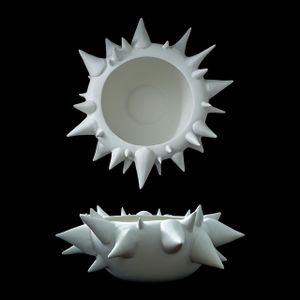
Elica Studio > Styling
Name: CHORISIA Material: Porcelain, engobes, oxides, glaze Finishing: Matte Sizes (cm): Approx. 40 (diameter/width) × 16 (height) Weight (g): ~2400 Designed in: 2021 Collection: Naturalia Lead Time: 30 days Description: The CHORISIA, an extraordinary sculptural bowl from Elica Studio's compelling "Naturalia" collection, represents a bold foray into biomorphic design, crafted to challenge perceptions and captivate the beholder. Designed in 2021, this piece is a testament to the studio's innovative spirit, offering interior designers a truly unique statement for spaces that demand originality, artistic courage, and a tangible connection to the wilder side of nature. It embodies a delicate balance between potential aggression and serene beauty, making it a powerful focal point in any contemporary or avant-garde interior. Meticulously crafted from high-quality porcelain, the CHORISIA features a comprehensive application of engobes, oxides, and glaze, culminating in a distinctive matte finish. This treatment lends the piece a chalky, almost organic texture, enhancing its sculptural quality and preventing any harsh reflections. As vividly depicted in the accompanying image, the bowl’s most striking feature is its exterior, densely adorned with sharp, angular spikes that radiate outwards. These protrusions transform the conventional bowl form into a dynamic, almost defensive organic structure, reminiscent of thorny seed pods, sea urchins, or even crystalline geological formations. The uniform white color emphasizes its sculptural form, allowing the play of light and shadow on its complex surfaces to create dramatic visual interest. In stark contrast to its spiky exterior, the interior of the CHORISIA remains smooth and inviting, offering a serene, unblemished surface that emphasizes its functionality as a bowl while retaining its artistic integrity. This juxtaposition of a formidable exterior with a smooth, refined interior speaks to a thoughtful design philosophy that marries protection with receptivity. For interior designers, this piece offers unparalleled versatility. While it can serve as a dramatic decorative bowl for minimalist objects, its primary impact lies in its sculptural presence. It’s an ideal choice for a prominent position on a large coffee table, a console in an open-plan living space, or as a distinctive element within a curated art collection. Weighing approximately 2400 grams and measuring around 40 cm in its widest dimension with a height of 16 cm, the CHORISIA possesses a substantial yet accessible presence. Its unique form ensures it commands attention without overwhelming the space, making it suitable for a variety of high-end residential and commercial environments. The "Naturalia" collection explores the abstract beauty of the natural world, and the CHORISIA, with its thorny, almost botanical appearance, perfectly encapsulates this theme. It introduces an element of wild, untamed nature, yet presented in a highly refined and artistic manner. This piece speaks to a desire for raw, authentic beauty, interpreted through the lens of sophisticated ceramic craftsmanship. Designed in 2021, the CHORISIA maintains its contemporary relevance, establishing itself as a timeless piece that continues to push the boundaries of decorative art. For interior designers seeking to inject a sense of fearless style, tactile intrigue, and a definitively unique statement into their projects, this bowl is an exceptional choice. Its daring form, meticulous craftsmanship, and striking visual impact make it a truly memorable addition. With a standard lead time of 30 days, incorporating this exceptional piece into project timelines is straightforward, promising to deliver a profound artistic statement that elevates the overall ambiance of any discerning interior, inviting contemplation and admiration for its extraordinary design.
CHORISIA-2
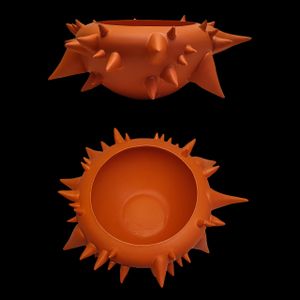
Elica Studio > Styling
Name: CHORISIA-2 Material: Porcelain, engobes, oxides, glaze Finishing: Matte Sizes (cm): Approx. 40 (diameter/width) × 16 (height) Weight (g): ~2400 Designed in: 2021 Collection: Naturalia Lead Time: 30 days Description: The CHORISIA-2, an extraordinary sculptural bowl from Elica Studio's compelling "Naturalia" collection, represents a vibrant evolution of its biomorphic design, specifically crafted to ignite imagination and captivate attention in refined interiors. Designed in 2021, this piece is a testament to the studio's innovative spirit, offering interior designers a truly unique statement for spaces that demand originality, artistic courage, and a tangible connection to the more vibrant aspects of the natural world. It masterfully balances a seemingly aggressive form with a warm, inviting hue, making it a powerful and versatile focal point in contemporary or eclectic design schemes. Meticulously crafted from high-quality porcelain, the CHORISIA-2 features a comprehensive application of engobes, oxides, and glaze, culminating in a distinctive matte finish. This treatment lends the piece a warm, tactile presence, enhancing its sculptural quality and preventing any harsh reflections. As vividly depicted in the accompanying image, the bowl’s most striking feature is its exterior, densely adorned with sharp, angular spikes that radiate outwards. These bold protrusions transform the conventional bowl form into a dynamic, almost defensive organic structure, reminiscent of a protective seed pod, a vibrant sea urchin, or even a stylized, sun-baked desert plant. The uniform orange/terracotta color deeply connects it to earthy tones, evoking sunsets, rich clays, or autumnal landscapes, while the matte finish provides an authentic, grounded feel. In stark contrast to its spiky, textural exterior, the interior of the CHORISIA-2 remains smooth and inviting, offering a serene, unblemished surface that emphasizes its functionality as a bowl while retaining its artistic integrity. This juxtaposition of a visually striking exterior with a refined, usable interior speaks to a thoughtful design philosophy that marries protection with receptivity. For interior designers, this piece offers unparalleled versatility. While it can serve as a dramatic decorative bowl for minimalist objects, its primary impact lies in its sculptural presence. It’s an ideal choice for a prominent position on a large coffee table, a console in an open-plan living space, or as a distinctive element within a curated art collection, injecting a burst of sophisticated color. Weighing approximately 2400 grams and measuring around 40 cm in its widest dimension with a height of 16 cm, the CHORISIA-2 possesses a substantial yet accessible presence. Its unique form ensures it commands attention without overwhelming the space, making it suitable for a variety of high-end residential and commercial environments. The "Naturalia" collection explores the abstract beauty of the natural world, and the CHORISIA-2, with its vibrant, thorny, almost botanical appearance, perfectly encapsulates this theme. It introduces an element of wild, untamed nature, yet presented in a highly refined and artistic manner. This piece speaks to a desire for raw, authentic beauty, interpreted through the lens of sophisticated ceramic craftsmanship, with an added layer of warm, inviting color. Designed in 2021, the CHORISIA-2 maintains its contemporary relevance, establishing itself as a timeless piece that continues to push the boundaries of decorative art. For interior designers seeking to imbue their projects with a sense of fearless style, tactile intrigue, and a definitively unique statement in a captivating hue, this bowl is an exceptional choice. Its daring form, meticulous craftsmanship, and striking visual impact make it a truly memorable addition. With a standard lead time of 30 days, incorporating this exceptional piece into project timelines is straightforward, promising to deliver a profound artistic statement that elevates the overall ambiance of any discerning interior, inviting contemplation and admiration for its extraordinary design and vibrant character.
VM22 MEDUSA
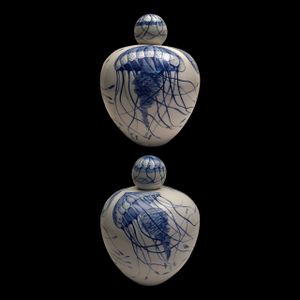
Elica Studio > Styling
Name: VM22 MEDUSA Material: Porcelain, glaze, oxides Finishing: Glossy Sizes (cm): Approx. 21 (height) × 36 (diameter) Weight (g): ~2000 (per jar) Designed in: 2022 Collection: Naturalia Lead Time: 30 days Description: The VM22 MEDUSA jars, an exquisitely crafted and serenely captivating collection from Elica Studio's "Naturalia" series, offer a breathtaking artistic interpretation of the enigmatic beauty of marine life. Designed in 2022, these unique lidded vessels transcend conventional decor, serving as sculptural masterpieces that bring a sense of fluid elegance, modern artistry, and oceanic tranquility to any interior. They are an ideal choice for interior designers seeking to infuse spaces with sophisticated natural themes, particularly those with a focus on marine biology, a serene blue and white palette, or an understated yet profound artistic statement. Masterfully crafted from fine porcelain, each VM22 MEDUSA jar is characterized by its smooth, pristine white body adorned with delicate blue illustrations. The entire piece is finished with a luxurious glossy glaze, which enhances its elegant, globular silhouette and provides a luminous surface that beautifully reflects light, mimicking the shimmering surface of water. As vividly illustrated in the accompanying image, each jar features a gracefully rounded body, culminating in a fitted spherical lid, which itself carries a subtle extension of the decorative motif. What truly defines these pieces are the intricate blue illustrations of jellyfish, or "Medusa," which seem to float effortlessly across the porcelain surface. The jellyfish are rendered with remarkable detail, their bell-shaped bodies depicted with translucent effects and their numerous tentacles trailing elegantly, creating a sense of graceful movement and depth. The fluid lines and varying shades of blue, achieved through the expert application of oxides, lend a watercolor-like softness to the illustrations, enhancing their ethereal quality. Subtle hints of smaller marine life or abstract patterns may also be integrated, enriching the narrative of an underwater world. The classic blue-and-white palette, reminiscent of traditional porcelain artistry, is given a contemporary twist through the modern subject matter and artistic execution. The VM22 MEDUSA jars, with their unique blend of natural inspiration, classic materials, and contemporary design, offer remarkable versatility for interior designers. They can function as exquisite decorative objects on their own, whether displayed individually or as a pair, commanding attention on a console table, a credenza, or as art within bespoke shelving. Their lidded design adds a layer of intrigue and practicality, allowing them to be admired purely for their sculptural form or to discreetly house small treasures. Their aesthetic is particularly well-suited for adding a touch of sophisticated calm to minimalist interiors, enhancing a coastal-inspired decor, or complementing a space with a global or art-focused theme. Belonging to the "Naturalia" collection, these pieces profoundly connect to nature, celebrating the mysterious and captivating forms of deep-sea creatures in a refined and artistic manner. With dimensions of approximately 21 cm in height and 36 cm in diameter, and weighing around 2000 grams per jar, the VM22 MEDUSA pieces possess a substantial and impressive presence. Their robust nature and considered size make them ideal for making a significant statement in luxury residences, high-end hotel suites, or sophisticated reception areas. Designed in 2022, the VM22 MEDUSA collection showcases contemporary design sensibilities and Elica Studio's innovative approach to ceramic art, ensuring its relevance in today's design landscape. For interior designers seeking to imbue their projects with unique character, a sense of refined artistry, and a touch of engaging natural serenity, the VM22 MEDUSA jars are an unparalleled choice. Their distinctive aesthetic, thoughtful integration of form and pattern, and captivating visual impact position them as investment pieces that will resonate with clients who appreciate bespoke quality, enduring design, and a connection to the artistic exploration of nature's profound and often unseen beauty. With a standard lead time of 30 days, incorporating these exceptional sculptures into project timelines is straightforward, promising to deliver a compelling visual experience that enhances the overall ambiance of any sophisticated interior.
Vivien - Milano-Bedding
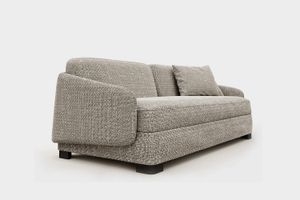
Milano Bedding > Sofa
VIVIEN by Milano Bedding – Feminine Elegance in a Sofa Bed with Hotel-Level Comfort Name: Vivien Material: Solid wood frame, polyurethane foam, steel Lampolet mechanism Finishing: Fixed or removable fabric or leather upholstery, painted metal legs Sizes (cm): Width 180–220 | Depth 100 | Height 82 | Bed size 140×200 or 160×200 Weight: Approx. 110–125 kg Designed in: Italy Collection: Milano Bedding Sofa Beds Lead Time: 30 days 2D/3D Files: Available for download Graceful Design with Smart Functionality The Vivien by Milano Bedding is a refined sofa bed that brings together softness, subtle curves, and a deeply feminine silhouette. Its compact proportions and elegant lines make it ideal for boutique hotels, luxury apartments, and residential guest rooms where style must meet performance. What sets Vivien apart is its gently curved armrests, slim frame, and tailored detailing—yet it houses a full 17 cm thick mattress inside. Thanks to the Lampolet mechanism, it converts effortlessly into a real bed, ideal for daily use, with no need to remove cushions. Build, Upholstery & Finishing Touches Vivien’s structure is made from solid wood, ensuring durability in contract environments. The cushions are crafted from high-resilience polyurethane foam, offering ergonomic support while maintaining a light, elegant appearance. It’s available in fixed or removable upholstery—including textured linens, soft velvets, wool blends, and smooth leathers. Choose soft pastel tones, creamy neutrals, or rich shades to adapt Vivien to your project’s atmosphere. Metal legs, finished in matt black or bronze, keep the look modern and minimal while adding lift and visual airiness. Perfect for Hospitality & Residential Projects Vivien is designed for spaces that need a compact, graceful sofa with true sleeping functionality, such as: Boutique hotel suites or high-end short-stay apartments Guest bedrooms or home libraries with dual use Luxury studio flats or co-living units Reception areas or VIP lounges where elegance is key Compact residential living rooms seeking sophistication and flexibility Its removable cover option makes it ideal for hospitality environments, where easy maintenance is essential. Style Direction and Interior Compatibility Vivien’s visual appeal lies in its curved armrests, slender back, and refined piping. The form is romantic but not ornate, and works well in Scandinavian, Japandi, or modern Parisian-style interiors. Styling options range from neutral and minimalist to warm and textural, depending on the selected fabric. It pairs beautifully with round coffee tables, layered rugs, and soft lighting—creating an inviting, boutique-hotel atmosphere. Specifications & Customisation Options Bed sizes: 140×200 cm or 160×200 cm Mattress height: 17 cm, available in polyurethane or memory foam Easy-to-open mechanism; no need to remove cushions Optional removable cover for convenience Matching scatter cushions and headrests available Explore Alternatives in the Collection If you love Vivien’s softness but are looking for different silhouettes, explore: Marsalis – Strong architectural lines and tailored feel Clarke Quilted – Relaxed with informal quilted upholstery Ellington – Classic proportions with compact form Jarreau – Bold volume and deep seat for high-impact design All products are available with 2D and 3D files, streamlining the specification process for interior designers and architects. Vivien by Milano Bedding is the ultimate blend of Italian elegance and smart functionality—a compact, luxurious sofa bed that brings lightness, charm, and true comfort to any space.
Charles - Sofa Bed_Milano Bedding
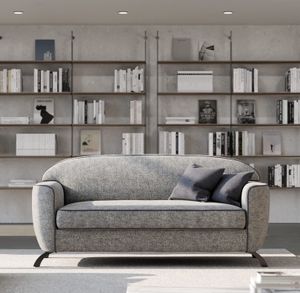
Milano Bedding > Sofa
CHARLES by Milano Bedding – Minimalist Sofa Bed with Linear Elegance and Integrated Comfort Name: Charles Material: Solid wood frame, polyurethane foam, steel Lampolet mechanism Finishing: Fixed or removable fabric/leather upholstery, slim metal legs Sizes (cm): Width 180–210 | Depth 100 | Height 85 | Bed size 140×200 or 160×200 Weight: Approx. 110–125 kg Designed in: Italy Collection: Milano Bedding Sofa Beds Lead Time: 30 days 2D/3D Files: Available for download Contemporary Simplicity with Integrated Sleeping Function The Charles by Milano Bedding is the go-to sofa bed for interiors that call for understated elegance, geometric precision, and true comfort. Designed with a clean, architectural silhouette, Charles features straight lines, minimal detailing, and a slim profile—making it ideal for urban apartments, contract lounges, boutique hotels, and guest-ready homes. Hidden within its streamlined form is a full 140×200 or 160×200 cm bed, with a 17 cm thick mattress and Milano Bedding’s patented Lampolet mechanism, allowing for daily use without removing seat or back cushions. Structure, Upholstery & Build Quality Charles is constructed with a solid wood frame and reinforced by a durable steel fold-out system, engineered for both residential and commercial use. The polyurethane foam seat and back cushions provide excellent support while maintaining a sleek, formal shape. Available in removable or fixed fabric and leather upholstery, Charles can be tailored in a wide variety of Milano Bedding textiles—from neutral wools and tactile linens to high-performance contract-grade fabrics. The slim metal legs, in matt black or custom finishes, give it a discreet lift and contemporary stance. Versatile for Compact & Elegant Interiors With its reduced depth and linear silhouette, Charles is perfect for: Hotel rooms and executive suites where space and elegance matter Serviced apartments, student housing, and short-stay rentals Guest rooms, home offices, or multi-functional living spaces Lobbies, reception areas, or workspace lounges in need of soft seating that converts into a bed Its minimalist design makes it a flexible match for many interior styles, especially where clean aesthetics and comfort must go hand in hand. Visual Language & Style Pairing Charles speaks the language of modern minimalism—sharp lines, crisp edges, and no unnecessary ornamentation. It fits seamlessly into Scandinavian, Japandi, urban industrial, and mid-century inspired interiors. Dress it in monochromatic tones for a sleek, tailored look, or add soft throws and scatter cushions to bring warmth and texture. Its timeless shape works equally well in neutral or colour-rich design schemes. Functional Highlights & Options Available as a 140×200 cm or 160×200 cm bed 17 cm thick mattress (polyurethane or memory foam) Quick-open mechanism with cushions attached Removable cover option for cleaning and reupholstery Add-ons: scatter cushions, bolsters, headrests, or matching ottoman Similar Sofa Beds in the Collection If you like the simplicity of Charles but need a different form, explore: Ellington – More classic in shape with narrow arms Goodman – Wider arms, generous seat, and similar architectural profile Marsalis – Mid-century elegance with tailored detailing Clarke Quilted – Relaxed feel with casual texture All models include 2D and 3D files, making it easy to integrate them into floorplans, renders, and technical drawings. Charles by Milano Bedding is a minimalist sofa bed that doesn’t shout but always delivers—perfect for stylish, compact interiors where clarity, comfort, and performance come first.
Chimera Empatia Bianco
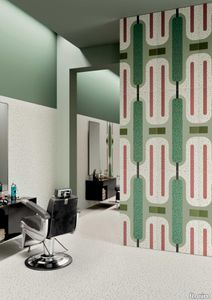
florim > Wall tile-stone-brick
In <em>Chimera,</em> Elena Salmistraro merges rigour with self-expression, in a graphic grammar laden with symbolic meaning. <em>Empatia </em>speaks to the emotions with graphics that interpret, through a highly individual abstract code, the stage make-up of a clown, with the aid of superimposed geometric forms and images. <em>Radici </em>is a tribal statement, a tribute to primitive ritual custom, evoked by the interplay between a sequence of triangles and rectangles and a set of figurative fragments. <em>Ritmo</em> is inspired by fabrics, suggesting the rhythmic alternation of woven yarns through a largely linear pattern. In <em>Colore, </em>the upheaval of a background of small isolated spots generated by a parametric digital program is combined with densely packed repeated forms. "The Chimera collection is rather like a book with four different chapters: I set out to differentiate these graphic motifs to create four totally different stories."<br></br>Elena Salmistraro It all starts with drawing. A <em>passion</em> for drawing. An <em>obsession</em> with drawing. Drawings like spider-webs, obsessively filling spaces, in a kind of manual choreography or gymnastics, a continuous flow. Elena Salmistraro draws all the time. She draws everywhere. Mostly on loose sheets or random surfaces. First and foremost with pen and pencil. Her drawings only acquire colour at a later stage. Often - just like Alessandro Mendini used to do - she draws "monsters": fascinating yet disturbing, subversive forms. The denser, more contorted the shape, the more obvious its underlying truth. For Elena, drawing is an intimate act. It is relaxing. And therapeutic. With an unrivalled communicative strength. Because drawing gives shape to ideas: you both give form to the world and reveal yourself. This passion, combined with natural graphic talent, has guided Elena Salmistraro in her project for Cedit: an experimental series of ceramic slabs produced using a high-definition 3D decorative technique. The explicit aim is to transform surfaces beyond their original flatness so that a new, visual and tactile, three-dimensional personality emerges, sweeping aside the coldness and uniformity that ceramic objects often inevitably convey.Elena Salmistraro has always viewed ceramics as a democratic material, in view of their accessibility, and the infinite potentials for shaping matter that they provide. She began working and experimenting with ceramics very early in her career, just after she graduated from the Milan Politecnico in 2008. She came into contact with small artistic craft firms specialising in smallproduction lots, and cut her teeth on projects that demanded the hand-processing of every detail, and finishes of high artistic value, for the high end of the market. The large corporations and galleries came later, but here again Elena kept faith with her desire to make mass-produced pieces unique, and to combine artistic value with specifically industrial characteristics. The monkey-shaped <em>Primates</em> vases reflect this method and intention, aiming to excite, surprise and charm. Antiminimalist and hyper-figurative, playful, ironic and a rich image-maker, often drawing on anthropology and magic, over the years Salmistraro has built up her own fantastic universe, inhabited by ceramic bestiaries, painted jungles and a cabinet like a one-eyed cyclops , always finding inspiration and inputs in nature and always aiming to reveal the extraordinary in the everyday. Given this background, it was almost inevitable she would work with Cedit: constantly seeking new talents and new approaches, as well as designs that break down the boundaries of ceramics and release them into the realm of art and innovation, the Modena company has recognised Elena Salmistraro as a leading contemporary creative spirit and involved her in a project intended to experiment with fresh ideas in materials and synaesthetics.Salmistraro's collection for Cedit is entitled <em>Chimera</em> and consists of large ceramic slabs, which can be enjoyed not only visually, through their patterns and colours, but also on a tactile level. Like the chimera in the "grotesque" tradition, monstrous in the etymological sense of the word with its merging of hybrid animal and vegetable shapes, the Cedit project attempts to originate a synaesthetic form of ceramics, through a three-dimensional development that exactly reproduces the texture of leathers and fabrics, creating an absolutely new kind of layered effect, with a tactile awareness that recalls the passion of grand master Ettore Sottsass for "surfaces that talk". And the surfaces of the slabs Salmistraro has created really seem to talk: in <em>Empatia </em>clown faces add theatricality to the cold gleam of marbles, interspersed with references to Art Déco graphics; <em>Radici</em> uses the textures of leathers and hide as if to re-establish a link between ceramics and other materials at the origins of human activity and creativity; in <em>Ritmo</em> the texture of cloth dialogues with pottery, almost in homage to the tactile rationalism of warp and weft, of which Bauhaus pioneer Anni Albers was one of the most expressive past interpreters ; finally, <em>Colore</em> has a spotted base generated by computer to underline the contrast between analogue and digital, the graphic sign and the matter into which it is impressed. It is an aesthetic of superimposition and mixing, and especially of synaesthesia: as in her drawings, in the <em>Chimera </em>slabs Elena Salmistraro's art is one of movement and acceleration. A process not of representation but of exploration. Of the world and of oneself. Almost a kind of Zen, for distancing oneself from the world to understand it more fully. In every sense.
Chimera Ritmo Beige

florim > Wallcovering
In <em>Chimera,</em> Elena Salmistraro merges rigour with self-expression, in a graphic grammar laden with symbolic meaning. <em>Empatia </em>speaks to the emotions with graphics that interpret, through a highly individual abstract code, the stage make-up of a clown, with the aid of superimposed geometric forms and images. <em>Radici </em>is a tribal statement, a tribute to primitive ritual custom, evoked by the interplay between a sequence of triangles and rectangles and a set of figurative fragments. <em>Ritmo</em> is inspired by fabrics, suggesting the rhythmic alternation of woven yarns through a largely linear pattern. In <em>Colore, </em>the upheaval of a background of small isolated spots generated by a parametric digital program is combined with densely packed repeated forms. "The Chimera collection is rather like a book with four different chapters: I set out to differentiate these graphic motifs to create four totally different stories."<br></br>Elena Salmistraro It all starts with drawing. A <em>passion</em> for drawing. An <em>obsession</em> with drawing. Drawings like spider-webs, obsessively filling spaces, in a kind of manual choreography or gymnastics, a continuous flow. Elena Salmistraro draws all the time. She draws everywhere. Mostly on loose sheets or random surfaces. First and foremost with pen and pencil. Her drawings only acquire colour at a later stage. Often - just like Alessandro Mendini used to do - she draws "monsters": fascinating yet disturbing, subversive forms. The denser, more contorted the shape, the more obvious its underlying truth. For Elena, drawing is an intimate act. It is relaxing. And therapeutic. With an unrivalled communicative strength. Because drawing gives shape to ideas: you both give form to the world and reveal yourself. This passion, combined with natural graphic talent, has guided Elena Salmistraro in her project for Cedit: an experimental series of ceramic slabs produced using a high-definition 3D decorative technique. The explicit aim is to transform surfaces beyond their original flatness so that a new, visual and tactile, three-dimensional personality emerges, sweeping aside the coldness and uniformity that ceramic objects often inevitably convey.Elena Salmistraro has always viewed ceramics as a democratic material, in view of their accessibility, and the infinite potentials for shaping matter that they provide. She began working and experimenting with ceramics very early in her career, just after she graduated from the Milan Politecnico in 2008. She came into contact with small artistic craft firms specialising in smallproduction lots, and cut her teeth on projects that demanded the hand-processing of every detail, and finishes of high artistic value, for the high end of the market. The large corporations and galleries came later, but here again Elena kept faith with her desire to make mass-produced pieces unique, and to combine artistic value with specifically industrial characteristics. The monkey-shaped <em>Primates</em> vases reflect this method and intention, aiming to excite, surprise and charm. Antiminimalist and hyper-figurative, playful, ironic and a rich image-maker, often drawing on anthropology and magic, over the years Salmistraro has built up her own fantastic universe, inhabited by ceramic bestiaries, painted jungles and a cabinet like a one-eyed cyclops , always finding inspiration and inputs in nature and always aiming to reveal the extraordinary in the everyday. Given this background, it was almost inevitable she would work with Cedit: constantly seeking new talents and new approaches, as well as designs that break down the boundaries of ceramics and release them into the realm of art and innovation, the Modena company has recognised Elena Salmistraro as a leading contemporary creative spirit and involved her in a project intended to experiment with fresh ideas in materials and synaesthetics.Salmistraro's collection for Cedit is entitled <em>Chimera</em> and consists of large ceramic slabs, which can be enjoyed not only visually, through their patterns and colours, but also on a tactile level. Like the chimera in the "grotesque" tradition, monstrous in the etymological sense of the word with its merging of hybrid animal and vegetable shapes, the Cedit project attempts to originate a synaesthetic form of ceramics, through a three-dimensional development that exactly reproduces the texture of leathers and fabrics, creating an absolutely new kind of layered effect, with a tactile awareness that recalls the passion of grand master Ettore Sottsass for "surfaces that talk". And the surfaces of the slabs Salmistraro has created really seem to talk: in <em>Empatia </em>clown faces add theatricality to the cold gleam of marbles, interspersed with references to Art Déco graphics; <em>Radici</em> uses the textures of leathers and hide as if to re-establish a link between ceramics and other materials at the origins of human activity and creativity; in <em>Ritmo</em> the texture of cloth dialogues with pottery, almost in homage to the tactile rationalism of warp and weft, of which Bauhaus pioneer Anni Albers was one of the most expressive past interpreters ; finally, <em>Colore</em> has a spotted base generated by computer to underline the contrast between analogue and digital, the graphic sign and the matter into which it is impressed. It is an aesthetic of superimposition and mixing, and especially of synaesthesia: as in her drawings, in the <em>Chimera </em>slabs Elena Salmistraro's art is one of movement and acceleration. A process not of representation but of exploration. Of the world and of oneself. Almost a kind of Zen, for distancing oneself from the world to understand it more fully. In every sense.
Chimera Radici Grigio

florim > Wallcovering
In <em>Chimera,</em> Elena Salmistraro merges rigour with self-expression, in a graphic grammar laden with symbolic meaning. <em>Empatia </em>speaks to the emotions with graphics that interpret, through a highly individual abstract code, the stage make-up of a clown, with the aid of superimposed geometric forms and images. <em>Radici </em>is a tribal statement, a tribute to primitive ritual custom, evoked by the interplay between a sequence of triangles and rectangles and a set of figurative fragments. <em>Ritmo</em> is inspired by fabrics, suggesting the rhythmic alternation of woven yarns through a largely linear pattern. In <em>Colore, </em>the upheaval of a background of small isolated spots generated by a parametric digital program is combined with densely packed repeated forms. "The Chimera collection is rather like a book with four different chapters: I set out to differentiate these graphic motifs to create four totally different stories."<br></br>Elena Salmistraro It all starts with drawing. A <em>passion</em> for drawing. An <em>obsession</em> with drawing. Drawings like spider-webs, obsessively filling spaces, in a kind of manual choreography or gymnastics, a continuous flow. Elena Salmistraro draws all the time. She draws everywhere. Mostly on loose sheets or random surfaces. First and foremost with pen and pencil. Her drawings only acquire colour at a later stage. Often - just like Alessandro Mendini used to do - she draws "monsters": fascinating yet disturbing, subversive forms. The denser, more contorted the shape, the more obvious its underlying truth. For Elena, drawing is an intimate act. It is relaxing. And therapeutic. With an unrivalled communicative strength. Because drawing gives shape to ideas: you both give form to the world and reveal yourself. This passion, combined with natural graphic talent, has guided Elena Salmistraro in her project for Cedit: an experimental series of ceramic slabs produced using a high-definition 3D decorative technique. The explicit aim is to transform surfaces beyond their original flatness so that a new, visual and tactile, three-dimensional personality emerges, sweeping aside the coldness and uniformity that ceramic objects often inevitably convey.Elena Salmistraro has always viewed ceramics as a democratic material, in view of their accessibility, and the infinite potentials for shaping matter that they provide. She began working and experimenting with ceramics very early in her career, just after she graduated from the Milan Politecnico in 2008. She came into contact with small artistic craft firms specialising in smallproduction lots, and cut her teeth on projects that demanded the hand-processing of every detail, and finishes of high artistic value, for the high end of the market. The large corporations and galleries came later, but here again Elena kept faith with her desire to make mass-produced pieces unique, and to combine artistic value with specifically industrial characteristics. The monkey-shaped <em>Primates</em> vases reflect this method and intention, aiming to excite, surprise and charm. Antiminimalist and hyper-figurative, playful, ironic and a rich image-maker, often drawing on anthropology and magic, over the years Salmistraro has built up her own fantastic universe, inhabited by ceramic bestiaries, painted jungles and a cabinet like a one-eyed cyclops , always finding inspiration and inputs in nature and always aiming to reveal the extraordinary in the everyday. Given this background, it was almost inevitable she would work with Cedit: constantly seeking new talents and new approaches, as well as designs that break down the boundaries of ceramics and release them into the realm of art and innovation, the Modena company has recognised Elena Salmistraro as a leading contemporary creative spirit and involved her in a project intended to experiment with fresh ideas in materials and synaesthetics.Salmistraro's collection for Cedit is entitled <em>Chimera</em> and consists of large ceramic slabs, which can be enjoyed not only visually, through their patterns and colours, but also on a tactile level. Like the chimera in the "grotesque" tradition, monstrous in the etymological sense of the word with its merging of hybrid animal and vegetable shapes, the Cedit project attempts to originate a synaesthetic form of ceramics, through a three-dimensional development that exactly reproduces the texture of leathers and fabrics, creating an absolutely new kind of layered effect, with a tactile awareness that recalls the passion of grand master Ettore Sottsass for "surfaces that talk". And the surfaces of the slabs Salmistraro has created really seem to talk: in <em>Empatia </em>clown faces add theatricality to the cold gleam of marbles, interspersed with references to Art Déco graphics; <em>Radici</em> uses the textures of leathers and hide as if to re-establish a link between ceramics and other materials at the origins of human activity and creativity; in <em>Ritmo</em> the texture of cloth dialogues with pottery, almost in homage to the tactile rationalism of warp and weft, of which Bauhaus pioneer Anni Albers was one of the most expressive past interpreters ; finally, <em>Colore</em> has a spotted base generated by computer to underline the contrast between analogue and digital, the graphic sign and the matter into which it is impressed. It is an aesthetic of superimposition and mixing, and especially of synaesthesia: as in her drawings, in the <em>Chimera </em>slabs Elena Salmistraro's art is one of movement and acceleration. A process not of representation but of exploration. Of the world and of oneself. Almost a kind of Zen, for distancing oneself from the world to understand it more fully. In every sense.
Chimera Radici Beige

florim > Wallcovering
In <em>Chimera,</em> Elena Salmistraro merges rigour with self-expression, in a graphic grammar laden with symbolic meaning. <em>Empatia </em>speaks to the emotions with graphics that interpret, through a highly individual abstract code, the stage make-up of a clown, with the aid of superimposed geometric forms and images. <em>Radici </em>is a tribal statement, a tribute to primitive ritual custom, evoked by the interplay between a sequence of triangles and rectangles and a set of figurative fragments. <em>Ritmo</em> is inspired by fabrics, suggesting the rhythmic alternation of woven yarns through a largely linear pattern. In <em>Colore, </em>the upheaval of a background of small isolated spots generated by a parametric digital program is combined with densely packed repeated forms. "The Chimera collection is rather like a book with four different chapters: I set out to differentiate these graphic motifs to create four totally different stories."<br></br>Elena Salmistraro It all starts with drawing. A <em>passion</em> for drawing. An <em>obsession</em> with drawing. Drawings like spider-webs, obsessively filling spaces, in a kind of manual choreography or gymnastics, a continuous flow. Elena Salmistraro draws all the time. She draws everywhere. Mostly on loose sheets or random surfaces. First and foremost with pen and pencil. Her drawings only acquire colour at a later stage. Often - just like Alessandro Mendini used to do - she draws "monsters": fascinating yet disturbing, subversive forms. The denser, more contorted the shape, the more obvious its underlying truth. For Elena, drawing is an intimate act. It is relaxing. And therapeutic. With an unrivalled communicative strength. Because drawing gives shape to ideas: you both give form to the world and reveal yourself. This passion, combined with natural graphic talent, has guided Elena Salmistraro in her project for Cedit: an experimental series of ceramic slabs produced using a high-definition 3D decorative technique. The explicit aim is to transform surfaces beyond their original flatness so that a new, visual and tactile, three-dimensional personality emerges, sweeping aside the coldness and uniformity that ceramic objects often inevitably convey.Elena Salmistraro has always viewed ceramics as a democratic material, in view of their accessibility, and the infinite potentials for shaping matter that they provide. She began working and experimenting with ceramics very early in her career, just after she graduated from the Milan Politecnico in 2008. She came into contact with small artistic craft firms specialising in smallproduction lots, and cut her teeth on projects that demanded the hand-processing of every detail, and finishes of high artistic value, for the high end of the market. The large corporations and galleries came later, but here again Elena kept faith with her desire to make mass-produced pieces unique, and to combine artistic value with specifically industrial characteristics. The monkey-shaped <em>Primates</em> vases reflect this method and intention, aiming to excite, surprise and charm. Antiminimalist and hyper-figurative, playful, ironic and a rich image-maker, often drawing on anthropology and magic, over the years Salmistraro has built up her own fantastic universe, inhabited by ceramic bestiaries, painted jungles and a cabinet like a one-eyed cyclops , always finding inspiration and inputs in nature and always aiming to reveal the extraordinary in the everyday. Given this background, it was almost inevitable she would work with Cedit: constantly seeking new talents and new approaches, as well as designs that break down the boundaries of ceramics and release them into the realm of art and innovation, the Modena company has recognised Elena Salmistraro as a leading contemporary creative spirit and involved her in a project intended to experiment with fresh ideas in materials and synaesthetics.Salmistraro's collection for Cedit is entitled <em>Chimera</em> and consists of large ceramic slabs, which can be enjoyed not only visually, through their patterns and colours, but also on a tactile level. Like the chimera in the "grotesque" tradition, monstrous in the etymological sense of the word with its merging of hybrid animal and vegetable shapes, the Cedit project attempts to originate a synaesthetic form of ceramics, through a three-dimensional development that exactly reproduces the texture of leathers and fabrics, creating an absolutely new kind of layered effect, with a tactile awareness that recalls the passion of grand master Ettore Sottsass for "surfaces that talk". And the surfaces of the slabs Salmistraro has created really seem to talk: in <em>Empatia </em>clown faces add theatricality to the cold gleam of marbles, interspersed with references to Art Déco graphics; <em>Radici</em> uses the textures of leathers and hide as if to re-establish a link between ceramics and other materials at the origins of human activity and creativity; in <em>Ritmo</em> the texture of cloth dialogues with pottery, almost in homage to the tactile rationalism of warp and weft, of which Bauhaus pioneer Anni Albers was one of the most expressive past interpreters ; finally, <em>Colore</em> has a spotted base generated by computer to underline the contrast between analogue and digital, the graphic sign and the matter into which it is impressed. It is an aesthetic of superimposition and mixing, and especially of synaesthesia: as in her drawings, in the <em>Chimera </em>slabs Elena Salmistraro's art is one of movement and acceleration. A process not of representation but of exploration. Of the world and of oneself. Almost a kind of Zen, for distancing oneself from the world to understand it more fully. In every sense.
Chimera Ritmo Azzurro

florim > Wallcovering
In <em>Chimera,</em> Elena Salmistraro merges rigour with self-expression, in a graphic grammar laden with symbolic meaning. <em>Empatia </em>speaks to the emotions with graphics that interpret, through a highly individual abstract code, the stage make-up of a clown, with the aid of superimposed geometric forms and images. <em>Radici </em>is a tribal statement, a tribute to primitive ritual custom, evoked by the interplay between a sequence of triangles and rectangles and a set of figurative fragments. <em>Ritmo</em> is inspired by fabrics, suggesting the rhythmic alternation of woven yarns through a largely linear pattern. In <em>Colore, </em>the upheaval of a background of small isolated spots generated by a parametric digital program is combined with densely packed repeated forms. "The Chimera collection is rather like a book with four different chapters: I set out to differentiate these graphic motifs to create four totally different stories."<br></br>Elena Salmistraro It all starts with drawing. A <em>passion</em> for drawing. An <em>obsession</em> with drawing. Drawings like spider-webs, obsessively filling spaces, in a kind of manual choreography or gymnastics, a continuous flow. Elena Salmistraro draws all the time. She draws everywhere. Mostly on loose sheets or random surfaces. First and foremost with pen and pencil. Her drawings only acquire colour at a later stage. Often - just like Alessandro Mendini used to do - she draws "monsters": fascinating yet disturbing, subversive forms. The denser, more contorted the shape, the more obvious its underlying truth. For Elena, drawing is an intimate act. It is relaxing. And therapeutic. With an unrivalled communicative strength. Because drawing gives shape to ideas: you both give form to the world and reveal yourself. This passion, combined with natural graphic talent, has guided Elena Salmistraro in her project for Cedit: an experimental series of ceramic slabs produced using a high-definition 3D decorative technique. The explicit aim is to transform surfaces beyond their original flatness so that a new, visual and tactile, three-dimensional personality emerges, sweeping aside the coldness and uniformity that ceramic objects often inevitably convey.Elena Salmistraro has always viewed ceramics as a democratic material, in view of their accessibility, and the infinite potentials for shaping matter that they provide. She began working and experimenting with ceramics very early in her career, just after she graduated from the Milan Politecnico in 2008. She came into contact with small artistic craft firms specialising in smallproduction lots, and cut her teeth on projects that demanded the hand-processing of every detail, and finishes of high artistic value, for the high end of the market. The large corporations and galleries came later, but here again Elena kept faith with her desire to make mass-produced pieces unique, and to combine artistic value with specifically industrial characteristics. The monkey-shaped <em>Primates</em> vases reflect this method and intention, aiming to excite, surprise and charm. Antiminimalist and hyper-figurative, playful, ironic and a rich image-maker, often drawing on anthropology and magic, over the years Salmistraro has built up her own fantastic universe, inhabited by ceramic bestiaries, painted jungles and a cabinet like a one-eyed cyclops , always finding inspiration and inputs in nature and always aiming to reveal the extraordinary in the everyday. Given this background, it was almost inevitable she would work with Cedit: constantly seeking new talents and new approaches, as well as designs that break down the boundaries of ceramics and release them into the realm of art and innovation, the Modena company has recognised Elena Salmistraro as a leading contemporary creative spirit and involved her in a project intended to experiment with fresh ideas in materials and synaesthetics.Salmistraro's collection for Cedit is entitled <em>Chimera</em> and consists of large ceramic slabs, which can be enjoyed not only visually, through their patterns and colours, but also on a tactile level. Like the chimera in the "grotesque" tradition, monstrous in the etymological sense of the word with its merging of hybrid animal and vegetable shapes, the Cedit project attempts to originate a synaesthetic form of ceramics, through a three-dimensional development that exactly reproduces the texture of leathers and fabrics, creating an absolutely new kind of layered effect, with a tactile awareness that recalls the passion of grand master Ettore Sottsass for "surfaces that talk". And the surfaces of the slabs Salmistraro has created really seem to talk: in <em>Empatia </em>clown faces add theatricality to the cold gleam of marbles, interspersed with references to Art Déco graphics; <em>Radici</em> uses the textures of leathers and hide as if to re-establish a link between ceramics and other materials at the origins of human activity and creativity; in <em>Ritmo</em> the texture of cloth dialogues with pottery, almost in homage to the tactile rationalism of warp and weft, of which Bauhaus pioneer Anni Albers was one of the most expressive past interpreters ; finally, <em>Colore</em> has a spotted base generated by computer to underline the contrast between analogue and digital, the graphic sign and the matter into which it is impressed. It is an aesthetic of superimposition and mixing, and especially of synaesthesia: as in her drawings, in the <em>Chimera </em>slabs Elena Salmistraro's art is one of movement and acceleration. A process not of representation but of exploration. Of the world and of oneself. Almost a kind of Zen, for distancing oneself from the world to understand it more fully. In every sense.
Chimera Empatia Nero

florim > Wall tile-stone-brick
In <em>Chimera,</em> Elena Salmistraro merges rigour with self-expression, in a graphic grammar laden with symbolic meaning. <em>Empatia </em>speaks to the emotions with graphics that interpret, through a highly individual abstract code, the stage make-up of a clown, with the aid of superimposed geometric forms and images. <em>Radici </em>is a tribal statement, a tribute to primitive ritual custom, evoked by the interplay between a sequence of triangles and rectangles and a set of figurative fragments. <em>Ritmo</em> is inspired by fabrics, suggesting the rhythmic alternation of woven yarns through a largely linear pattern. In <em>Colore, </em>the upheaval of a background of small isolated spots generated by a parametric digital program is combined with densely packed repeated forms. "The Chimera collection is rather like a book with four different chapters: I set out to differentiate these graphic motifs to create four totally different stories."<br></br>Elena Salmistraro It all starts with drawing. A <em>passion</em> for drawing. An <em>obsession</em> with drawing. Drawings like spider-webs, obsessively filling spaces, in a kind of manual choreography or gymnastics, a continuous flow. Elena Salmistraro draws all the time. She draws everywhere. Mostly on loose sheets or random surfaces. First and foremost with pen and pencil. Her drawings only acquire colour at a later stage. Often - just like Alessandro Mendini used to do - she draws "monsters": fascinating yet disturbing, subversive forms. The denser, more contorted the shape, the more obvious its underlying truth. For Elena, drawing is an intimate act. It is relaxing. And therapeutic. With an unrivalled communicative strength. Because drawing gives shape to ideas: you both give form to the world and reveal yourself. This passion, combined with natural graphic talent, has guided Elena Salmistraro in her project for Cedit: an experimental series of ceramic slabs produced using a high-definition 3D decorative technique. The explicit aim is to transform surfaces beyond their original flatness so that a new, visual and tactile, three-dimensional personality emerges, sweeping aside the coldness and uniformity that ceramic objects often inevitably convey.Elena Salmistraro has always viewed ceramics as a democratic material, in view of their accessibility, and the infinite potentials for shaping matter that they provide. She began working and experimenting with ceramics very early in her career, just after she graduated from the Milan Politecnico in 2008. She came into contact with small artistic craft firms specialising in smallproduction lots, and cut her teeth on projects that demanded the hand-processing of every detail, and finishes of high artistic value, for the high end of the market. The large corporations and galleries came later, but here again Elena kept faith with her desire to make mass-produced pieces unique, and to combine artistic value with specifically industrial characteristics. The monkey-shaped <em>Primates</em> vases reflect this method and intention, aiming to excite, surprise and charm. Antiminimalist and hyper-figurative, playful, ironic and a rich image-maker, often drawing on anthropology and magic, over the years Salmistraro has built up her own fantastic universe, inhabited by ceramic bestiaries, painted jungles and a cabinet like a one-eyed cyclops , always finding inspiration and inputs in nature and always aiming to reveal the extraordinary in the everyday. Given this background, it was almost inevitable she would work with Cedit: constantly seeking new talents and new approaches, as well as designs that break down the boundaries of ceramics and release them into the realm of art and innovation, the Modena company has recognised Elena Salmistraro as a leading contemporary creative spirit and involved her in a project intended to experiment with fresh ideas in materials and synaesthetics.Salmistraro's collection for Cedit is entitled <em>Chimera</em> and consists of large ceramic slabs, which can be enjoyed not only visually, through their patterns and colours, but also on a tactile level. Like the chimera in the "grotesque" tradition, monstrous in the etymological sense of the word with its merging of hybrid animal and vegetable shapes, the Cedit project attempts to originate a synaesthetic form of ceramics, through a three-dimensional development that exactly reproduces the texture of leathers and fabrics, creating an absolutely new kind of layered effect, with a tactile awareness that recalls the passion of grand master Ettore Sottsass for "surfaces that talk". And the surfaces of the slabs Salmistraro has created really seem to talk: in <em>Empatia </em>clown faces add theatricality to the cold gleam of marbles, interspersed with references to Art Déco graphics; <em>Radici</em> uses the textures of leathers and hide as if to re-establish a link between ceramics and other materials at the origins of human activity and creativity; in <em>Ritmo</em> the texture of cloth dialogues with pottery, almost in homage to the tactile rationalism of warp and weft, of which Bauhaus pioneer Anni Albers was one of the most expressive past interpreters ; finally, <em>Colore</em> has a spotted base generated by computer to underline the contrast between analogue and digital, the graphic sign and the matter into which it is impressed. It is an aesthetic of superimposition and mixing, and especially of synaesthesia: as in her drawings, in the <em>Chimera </em>slabs Elena Salmistraro's art is one of movement and acceleration. A process not of representation but of exploration. Of the world and of oneself. Almost a kind of Zen, for distancing oneself from the world to understand it more fully. In every sense.
Chimera Colore Bianco

florim > Wall Paint
In <em>Chimera,</em> Elena Salmistraro merges rigour with self-expression, in a graphic grammar laden with symbolic meaning. <em>Empatia </em>speaks to the emotions with graphics that interpret, through a highly individual abstract code, the stage make-up of a clown, with the aid of superimposed geometric forms and images. <em>Radici </em>is a tribal statement, a tribute to primitive ritual custom, evoked by the interplay between a sequence of triangles and rectangles and a set of figurative fragments. <em>Ritmo</em> is inspired by fabrics, suggesting the rhythmic alternation of woven yarns through a largely linear pattern. In <em>Colore, </em>the upheaval of a background of small isolated spots generated by a parametric digital program is combined with densely packed repeated forms. "The Chimera collection is rather like a book with four different chapters: I set out to differentiate these graphic motifs to create four totally different stories."<br></br>Elena Salmistraro It all starts with drawing. A <em>passion</em> for drawing. An <em>obsession</em> with drawing. Drawings like spider-webs, obsessively filling spaces, in a kind of manual choreography or gymnastics, a continuous flow. Elena Salmistraro draws all the time. She draws everywhere. Mostly on loose sheets or random surfaces. First and foremost with pen and pencil. Her drawings only acquire colour at a later stage. Often - just like Alessandro Mendini used to do - she draws "monsters": fascinating yet disturbing, subversive forms. The denser, more contorted the shape, the more obvious its underlying truth. For Elena, drawing is an intimate act. It is relaxing. And therapeutic. With an unrivalled communicative strength. Because drawing gives shape to ideas: you both give form to the world and reveal yourself. This passion, combined with natural graphic talent, has guided Elena Salmistraro in her project for Cedit: an experimental series of ceramic slabs produced using a high-definition 3D decorative technique. The explicit aim is to transform surfaces beyond their original flatness so that a new, visual and tactile, three-dimensional personality emerges, sweeping aside the coldness and uniformity that ceramic objects often inevitably convey.Elena Salmistraro has always viewed ceramics as a democratic material, in view of their accessibility, and the infinite potentials for shaping matter that they provide. She began working and experimenting with ceramics very early in her career, just after she graduated from the Milan Politecnico in 2008. She came into contact with small artistic craft firms specialising in smallproduction lots, and cut her teeth on projects that demanded the hand-processing of every detail, and finishes of high artistic value, for the high end of the market. The large corporations and galleries came later, but here again Elena kept faith with her desire to make mass-produced pieces unique, and to combine artistic value with specifically industrial characteristics. The monkey-shaped <em>Primates</em> vases reflect this method and intention, aiming to excite, surprise and charm. Antiminimalist and hyper-figurative, playful, ironic and a rich image-maker, often drawing on anthropology and magic, over the years Salmistraro has built up her own fantastic universe, inhabited by ceramic bestiaries, painted jungles and a cabinet like a one-eyed cyclops , always finding inspiration and inputs in nature and always aiming to reveal the extraordinary in the everyday. Given this background, it was almost inevitable she would work with Cedit: constantly seeking new talents and new approaches, as well as designs that break down the boundaries of ceramics and release them into the realm of art and innovation, the Modena company has recognised Elena Salmistraro as a leading contemporary creative spirit and involved her in a project intended to experiment with fresh ideas in materials and synaesthetics.Salmistraro's collection for Cedit is entitled <em>Chimera</em> and consists of large ceramic slabs, which can be enjoyed not only visually, through their patterns and colours, but also on a tactile level. Like the chimera in the "grotesque" tradition, monstrous in the etymological sense of the word with its merging of hybrid animal and vegetable shapes, the Cedit project attempts to originate a synaesthetic form of ceramics, through a three-dimensional development that exactly reproduces the texture of leathers and fabrics, creating an absolutely new kind of layered effect, with a tactile awareness that recalls the passion of grand master Ettore Sottsass for "surfaces that talk". And the surfaces of the slabs Salmistraro has created really seem to talk: in <em>Empatia </em>clown faces add theatricality to the cold gleam of marbles, interspersed with references to Art Déco graphics; <em>Radici</em> uses the textures of leathers and hide as if to re-establish a link between ceramics and other materials at the origins of human activity and creativity; in <em>Ritmo</em> the texture of cloth dialogues with pottery, almost in homage to the tactile rationalism of warp and weft, of which Bauhaus pioneer Anni Albers was one of the most expressive past interpreters ; finally, <em>Colore</em> has a spotted base generated by computer to underline the contrast between analogue and digital, the graphic sign and the matter into which it is impressed. It is an aesthetic of superimposition and mixing, and especially of synaesthesia: as in her drawings, in the <em>Chimera </em>slabs Elena Salmistraro's art is one of movement and acceleration. A process not of representation but of exploration. Of the world and of oneself. Almost a kind of Zen, for distancing oneself from the world to understand it more fully. In every sense.
Chimera Colore Grigio

florim > Wall Paint
In <em>Chimera,</em> Elena Salmistraro merges rigour with self-expression, in a graphic grammar laden with symbolic meaning. <em>Empatia </em>speaks to the emotions with graphics that interpret, through a highly individual abstract code, the stage make-up of a clown, with the aid of superimposed geometric forms and images. <em>Radici </em>is a tribal statement, a tribute to primitive ritual custom, evoked by the interplay between a sequence of triangles and rectangles and a set of figurative fragments. <em>Ritmo</em> is inspired by fabrics, suggesting the rhythmic alternation of woven yarns through a largely linear pattern. In <em>Colore, </em>the upheaval of a background of small isolated spots generated by a parametric digital program is combined with densely packed repeated forms. "The Chimera collection is rather like a book with four different chapters: I set out to differentiate these graphic motifs to create four totally different stories."<br></br>Elena Salmistraro It all starts with drawing. A <em>passion</em> for drawing. An <em>obsession</em> with drawing. Drawings like spider-webs, obsessively filling spaces, in a kind of manual choreography or gymnastics, a continuous flow. Elena Salmistraro draws all the time. She draws everywhere. Mostly on loose sheets or random surfaces. First and foremost with pen and pencil. Her drawings only acquire colour at a later stage. Often - just like Alessandro Mendini used to do - she draws "monsters": fascinating yet disturbing, subversive forms. The denser, more contorted the shape, the more obvious its underlying truth. For Elena, drawing is an intimate act. It is relaxing. And therapeutic. With an unrivalled communicative strength. Because drawing gives shape to ideas: you both give form to the world and reveal yourself. This passion, combined with natural graphic talent, has guided Elena Salmistraro in her project for Cedit: an experimental series of ceramic slabs produced using a high-definition 3D decorative technique. The explicit aim is to transform surfaces beyond their original flatness so that a new, visual and tactile, three-dimensional personality emerges, sweeping aside the coldness and uniformity that ceramic objects often inevitably convey.Elena Salmistraro has always viewed ceramics as a democratic material, in view of their accessibility, and the infinite potentials for shaping matter that they provide. She began working and experimenting with ceramics very early in her career, just after she graduated from the Milan Politecnico in 2008. She came into contact with small artistic craft firms specialising in smallproduction lots, and cut her teeth on projects that demanded the hand-processing of every detail, and finishes of high artistic value, for the high end of the market. The large corporations and galleries came later, but here again Elena kept faith with her desire to make mass-produced pieces unique, and to combine artistic value with specifically industrial characteristics. The monkey-shaped <em>Primates</em> vases reflect this method and intention, aiming to excite, surprise and charm. Antiminimalist and hyper-figurative, playful, ironic and a rich image-maker, often drawing on anthropology and magic, over the years Salmistraro has built up her own fantastic universe, inhabited by ceramic bestiaries, painted jungles and a cabinet like a one-eyed cyclops , always finding inspiration and inputs in nature and always aiming to reveal the extraordinary in the everyday. Given this background, it was almost inevitable she would work with Cedit: constantly seeking new talents and new approaches, as well as designs that break down the boundaries of ceramics and release them into the realm of art and innovation, the Modena company has recognised Elena Salmistraro as a leading contemporary creative spirit and involved her in a project intended to experiment with fresh ideas in materials and synaesthetics.Salmistraro's collection for Cedit is entitled <em>Chimera</em> and consists of large ceramic slabs, which can be enjoyed not only visually, through their patterns and colours, but also on a tactile level. Like the chimera in the "grotesque" tradition, monstrous in the etymological sense of the word with its merging of hybrid animal and vegetable shapes, the Cedit project attempts to originate a synaesthetic form of ceramics, through a three-dimensional development that exactly reproduces the texture of leathers and fabrics, creating an absolutely new kind of layered effect, with a tactile awareness that recalls the passion of grand master Ettore Sottsass for "surfaces that talk". And the surfaces of the slabs Salmistraro has created really seem to talk: in <em>Empatia </em>clown faces add theatricality to the cold gleam of marbles, interspersed with references to Art Déco graphics; <em>Radici</em> uses the textures of leathers and hide as if to re-establish a link between ceramics and other materials at the origins of human activity and creativity; in <em>Ritmo</em> the texture of cloth dialogues with pottery, almost in homage to the tactile rationalism of warp and weft, of which Bauhaus pioneer Anni Albers was one of the most expressive past interpreters ; finally, <em>Colore</em> has a spotted base generated by computer to underline the contrast between analogue and digital, the graphic sign and the matter into which it is impressed. It is an aesthetic of superimposition and mixing, and especially of synaesthesia: as in her drawings, in the <em>Chimera </em>slabs Elena Salmistraro's art is one of movement and acceleration. A process not of representation but of exploration. Of the world and of oneself. Almost a kind of Zen, for distancing oneself from the world to understand it more fully. In every sense.
AWA - Blown glass pendant lamp _ BROKIS

BROKIS > Ceiling lamp
**Awa** is an elegant blown glass pendant lamp designed by Fumie Shibata, available in large and medium sizes with glass options including transparent, smoke grey, smoke brown, and a frosted finish. The design draws inspiration from the Japanese word *"Awa,"* meaning an air bubble suspended in liquid, creating the illusion of a luminous orb gently floating in space. The lamp’s wooden (American walnut or European oak) or metal (copper or dural) base mimics glass, resembling a stopper that seals in the air, adding a refined contrast to the delicate glass form. A newer version features a frosted upper half for a softer glow. A 3D file of the lamp is available for download, allowing for detailed visualization. **BROKIS**, the Czech-based lighting brand behind Awa, is renowned for its fusion of traditional craftsmanship and contemporary design, offering premium lighting solutions worldwide. Explore more at [www.brokis.cz](http://www.brokis.cz).